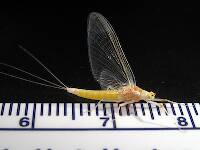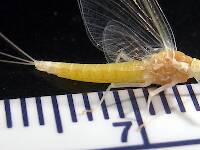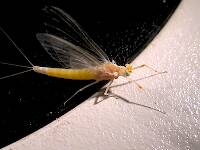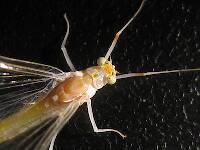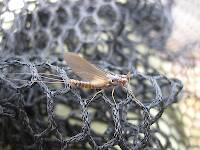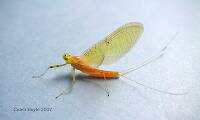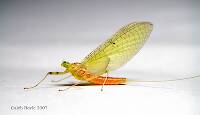
Blue-winged Olives
Baetis
Tiny Baetis mayflies are perhaps the most commonly encountered and imitated by anglers on all American trout streams due to their great abundance, widespread distribution, and trout-friendly emergence habits.
Featured on the forum

This dun emerged from a mature nymph on my desk. Unfortunately its wings didn't perfectly dry out.

Troutnut is a project started in 2003 by salmonid ecologist Jason "Troutnut" Neuswanger to help anglers and
fly tyers unabashedly embrace the entomological side of the sport. Learn more about Troutnut or
support the project for an enhanced experience here.
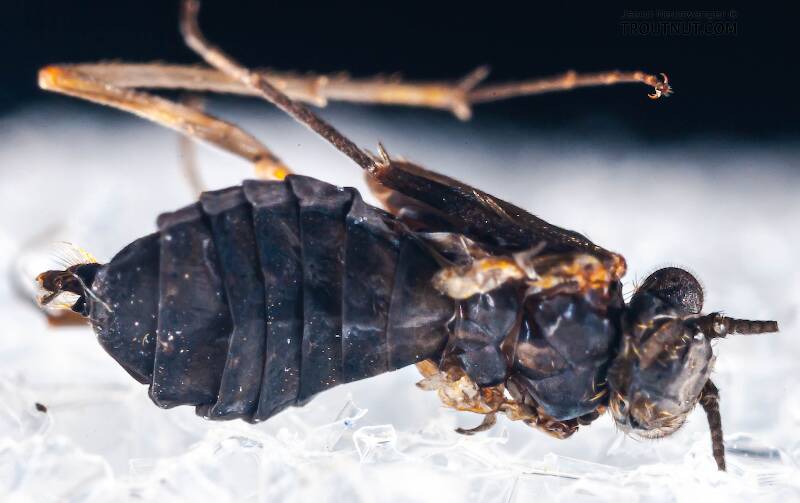
This is a really strange specimen. I would guess it's one of the dry caddis pupa that scoots across the surface of the water as a pupa rather than emerging right away. Its "wing pads" sure don't look right, though. Maybe they're deformed and that's why I was able to find this one as a pupa in the first place. It also looks like it might be a caddis adult missing its wings, but since I found three of them, that kind of rules out such an anomalous maiming.
I found this one and one other on a midstream rock. The previous day, I caught a similar creature kicking around on the water's surface.
This one died and shriveled a little bit before I could photograph it, but it's basically in its original shape.
I found this one and one other on a midstream rock. The previous day, I caught a similar creature kicking around on the water's surface.
This one died and shriveled a little bit before I could photograph it, but it's basically in its original shape.
Taxon on Jun 4, 2007June 4th, 2007, 11:08 am EDT
Ignoring the (perhaps deformed) wing pads, to me at least, the general body shape looks a lot more like a dragonfly nymph.
Troutnut on Jun 4, 2007June 4th, 2007, 12:11 pm EDT
The legs seem like they surely belong to a caddisfly, though, and the apparent genitalia wouldn't make any sense on a dragonfly nymph. It's also awfully small for one. You're right that the body seems unusually robust for a caddisfly, though.
Jason Neuswanger, Ph.D.
Troutnut and salmonid ecologist
Troutnut and salmonid ecologist
Ethanbr on Jun 5, 2007June 5th, 2007, 9:59 am EDT
It might sound odd, it could be a Dolophilodes distinctus (Trichoptera: Philopotamidae) female. Females are usually wingless, except in the warmest parts of the year, and males are sometimes wingless during winter emergence. You can see the developed genitalia at the end of the abdomen. You don't clearly see wing pads because they're very small, and they don't develop.
When - and specifically where - was the specimen collected?
When - and specifically where - was the specimen collected?
Troutnut on Jun 5, 2007June 5th, 2007, 10:08 am EDT
It was collected in Brodhead Creek in the Poconos last Tuesday (May 29th). I had forgotten that some Dolophilodes adults don't have developed wings at all. You're probably right.
Jason Neuswanger, Ph.D.
Troutnut and salmonid ecologist
Troutnut and salmonid ecologist
Taxon on Jun 5, 2007June 5th, 2007, 10:26 am EDT
Thanks, Ethan. I was confident we could count on you for an ID.
GONZO on Jun 5, 2007June 5th, 2007, 12:58 pm EDT
Jason, I'm glad that Ethan chimed in on this one. I've always assumed that these were Dolophilodes, and I'm sure you noticed how common the larvae were in the Pocono streams. It sure is a strange-looking bug to see close-up, and their emergence behavior is pretty strange as well.
PS--Ethan, it's nice to have you posting here.
PS--Ethan, it's nice to have you posting here.
Litobrancha on Jun 12, 2007June 12th, 2007, 8:01 am EDT
I'd suggest that this is a Chimarra male, probably in the C. socia/parasocia/obscura/moselyi/falculata/florida group. the wings likely broke off when the insect dried out.
socia records are all up and down the eastern seaboard, midwest and canada.
parasocia KY, MO, TN, LA, MS, AL and we have just collected this species in watauga co, NC.
rule out obscura since that species has a long thin projection on the ventral 9 segment.
moselyi is found in ohio and VA but i have no PA or NY records.
falculata from GA, FL, AL, MS
florida from LA, AL, MS, GA, SC, FL and surprisingly MD.
a good dorsal view of the terminal segments might shed some light on the identity.
socia records are all up and down the eastern seaboard, midwest and canada.
parasocia KY, MO, TN, LA, MS, AL and we have just collected this species in watauga co, NC.
rule out obscura since that species has a long thin projection on the ventral 9 segment.
moselyi is found in ohio and VA but i have no PA or NY records.
falculata from GA, FL, AL, MS
florida from LA, AL, MS, GA, SC, FL and surprisingly MD.
a good dorsal view of the terminal segments might shed some light on the identity.
GONZO on Jun 12, 2007June 12th, 2007, 8:28 am EDT
Hi Lito,
I was there when Jason captured this specimen, and I can attest that it had no wings when it was alive. It was a very athletic little critter and could run across the surface of the water. I always assumed that this behavior was a trait of Dolophilodes. Chimarra seem to crawl out to emerge. I've collected quite a few "pupae" just like this over the years in subsurface seine samples and they always sprint immediately off my net. Is there some character in particular that rules out Dolophilodes? By the way, the winged Dolophilodes adult you just identified was captured a day before on another stream in that area, and I thought I remembered Jason capturing a very similar adult at the same time we picked up this specimen. Help, I'm confused.
I was there when Jason captured this specimen, and I can attest that it had no wings when it was alive. It was a very athletic little critter and could run across the surface of the water. I always assumed that this behavior was a trait of Dolophilodes. Chimarra seem to crawl out to emerge. I've collected quite a few "pupae" just like this over the years in subsurface seine samples and they always sprint immediately off my net. Is there some character in particular that rules out Dolophilodes? By the way, the winged Dolophilodes adult you just identified was captured a day before on another stream in that area, and I thought I remembered Jason capturing a very similar adult at the same time we picked up this specimen. Help, I'm confused.
Litobrancha on Jun 12, 2007June 12th, 2007, 8:43 am EDT
Gonzo, Ross 1944 uses the apical spur count on front tibia to distinguish chimarra from dolophilodes and wormaldia, chimarra has one apical spur and the others 2... the armitage key from Ohio biological survey uses a wing character in the hind wing which won't help us here.
i can't see the spurs on the front legs from these photos, and after reconsidering I imagine that it could be a dolophilodes, esp if it is still in the pupal skin. either way i am sure it is a male and as far as i know there are no records of wingless dolophilodes males, only females. one good thing to check for would be if there is a sternal projection on the ventral ninth segment, if so then it is chimarra (even a short stub). if not probably dolophilodes.
i can't see the spurs on the front legs from these photos, and after reconsidering I imagine that it could be a dolophilodes, esp if it is still in the pupal skin. either way i am sure it is a male and as far as i know there are no records of wingless dolophilodes males, only females. one good thing to check for would be if there is a sternal projection on the ventral ninth segment, if so then it is chimarra (even a short stub). if not probably dolophilodes.
Litobrancha on Jun 12, 2007June 12th, 2007, 8:50 am EDT
on last thought hell it could be a female. i've got one under the scope right now, her junk sticks out a long ways posteriorly than I thought was usual. I'll hush now, until we get a spur count
:)
:)
GONZO on Jun 12, 2007June 12th, 2007, 9:00 am EDT
Thanks, Lito. And please don't hush on my account--I'm just trying to learn. These little buggers have puzzled and tormented me for years. In fact, I got a phone call from a Pocono fishing buddy about an hour or so ago who was reporting his frustration about a mystery hatch he encountered yesterday evening on the same stream where the winged Dolophilodes adult was captured. What he described sounded just like the strange emergence of what I have assumed was D. distinctus.
Troutnut on Jun 12, 2007June 12th, 2007, 3:16 pm EDT
Oh, the rotten luck! Both front tibiae have gone missing. All I have is two coxae with empty trochanters. Don't you hate it when that happens?
I'm pretty sure this specimen is not in a pupal shuck, and it's not merely a damaged adult. (Finding others in an identical configuration seems to rule out a close call with a dragonfly or other "wings fall off" disasters.)
I'm not sure what the sternal projection on the ventral 9th segment is supposed to look like. Do you know of a figure on any website or in any book I might have? This one is a little bumpy down there but I wouldn't know what to call a projection. The ab9 sternum comes to kind of a "peak" right in the middle, but there is no distinct tubercle or anything.
I also don't know whether it's male or female. The "junk" down there looks male, if I were to judge by what I know of mayflies, but I'm sure that's a mistake. Again I can't find a good diagram anywhere.
Another maybe-relevant detail: I collected this one and one other (which later escaped my container) up on top of a boulder in the middle of the river, not off the surface of the water. Gonzo and I found one which seemed to be the same thing on the surface of the water on a different stream the day before.
I'm pretty sure this specimen is not in a pupal shuck, and it's not merely a damaged adult. (Finding others in an identical configuration seems to rule out a close call with a dragonfly or other "wings fall off" disasters.)
I'm not sure what the sternal projection on the ventral 9th segment is supposed to look like. Do you know of a figure on any website or in any book I might have? This one is a little bumpy down there but I wouldn't know what to call a projection. The ab9 sternum comes to kind of a "peak" right in the middle, but there is no distinct tubercle or anything.
I also don't know whether it's male or female. The "junk" down there looks male, if I were to judge by what I know of mayflies, but I'm sure that's a mistake. Again I can't find a good diagram anywhere.
Another maybe-relevant detail: I collected this one and one other (which later escaped my container) up on top of a boulder in the middle of the river, not off the surface of the water. Gonzo and I found one which seemed to be the same thing on the surface of the water on a different stream the day before.
Jason Neuswanger, Ph.D.
Troutnut and salmonid ecologist
Troutnut and salmonid ecologist
Litobrancha on Jun 13, 2007June 13th, 2007, 2:11 am EDT
i'm beginning to buy the wingless dolophilodes female thing.... a chimarra male in the appropriate group would have a rather defined projection on the sternum.
are the genitalita segmented in any way? dolophilodes and chimarra and wormaldia and agapetus all tend to have a more or less sharp ridge ventrally in females, as you describe.
are the genitalita segmented in any way? dolophilodes and chimarra and wormaldia and agapetus all tend to have a more or less sharp ridge ventrally in females, as you describe.
Quick Reply
Related Discussions
Topic
Replies
Last Reply
8
Jun 5, 2007
by Dinerobyn
by Dinerobyn
0
May 3, 2007
by Troutnut
by Troutnut
3
Sep 4, 2012
by Entoman
by Entoman
1
Jun 12, 2007
by Troutnut
by Troutnut




